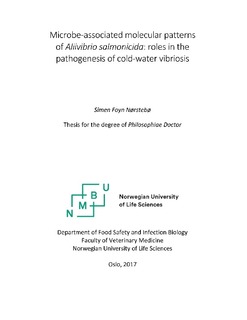| dc.description.abstract | Aliivibrio salmonicida is the cause of cold-water vibriosis, a hemorrhagic septicemia of
farmed salmonids. Previous reports have shown that Al. salmonicida is able to circumvent
defense systems of the fish host, and it has been suggested that the tissue damage
observed in moribund fish is associated with the immune response raised towards the
invading pathogen. This project was initiated to identify components of importance for
virulence and immunogenicity, in order to increase the understanding of interactions
between Al. salmonicida and its salmonid host.
For microbial detection and induction of defense systems, the host immune system relies
on microbe-associated molecular patterns (MAMPs), structures specific to microbes that
serve as signatures for microbial presence. In this thesis, two well-known MAMPs have
been investigated: flagellin of the flagellar motility apparatus, and lipopolysaccharide (LPS)
of the outer membrane. In addition to their roles as targets for the immune system, both
the flagellum and LPS serve important functions that aid bacterial survival. The results
presented here demonstrate that neither flagellar motility nor LPS are required for
invasion of salmon. However, both structures were shown to be involved in later stages of
disease development.
Results of challenge experiments demonstrated a function in virulence for the flagellar
flagellins. Interestingly, bacteria cultured in implants within the peritoneal cavity of salmon
showed an increase in production of flagellins, but not other components associated with
motility. Combined, these results indicate a motility-independent requirement for
flagellation in the cold-water vibriosis pathogenesis. However, the mechanisms involved
remain unknown.
In addition, the O-antigen moiety of LPS was shown to be essential for virulence. The
results of this thesis indicate that O-antigen contributes to survival within the host and
modulates the magnitude of the immune response raised in experimentally infected
salmon. These observations may relate to the presence of LPS in VS-P1, an outer
membrane complex that is shed from the bacterial surface and is hypothesized to decoy
the immune response away from bacterial cells.
While the findings of this thesis elucidate certain aspects of mechanisms involved in
virulence in Al. salmonicida, new questions have also been raised. Knowledge about
microbial pathogenesis is crucial for control of diseases, and this work may contribute to
improvement of prophylactic strategies for cold-water vibriosis as well as other bacterial
fish diseases. | nb_NO |

